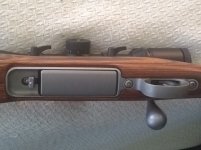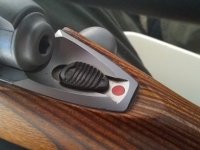Hello all,
I am trying to adjust my Savage 12 LPV trigger, I sent it to a smith for accurizing and now its too light and so it locks the safety. So I need to disassemble then reassemble the action from the stock in order to access the trigger, which seems to be straight forward.
I read in:
https://www.savageshooters.com/showthread.php?54235-what-torque-for-action-screws
and
https://www.accurateshooter.com/technical-articles/savage-action-screw-torque-tuning/
where they say that for laminate stocks the torque is supposed to be 30-35 inch-lbs, presumably 35 for the front and 25 to 30 for the rear. The process is to apparently tighten the front first, then moving on to the rear
My confusion is that my Savage has THREE screws (as you can see in the picture): one in front of the magazine well, two others holding the trigger guard, so which one is the front that I should tighten first and which one is the back?

I am assuming that the 2 forward screws are the ones to be done first, but I want to double check with those of you in TFL that have experience with Savage.
Thank you in advance for the help.
I am trying to adjust my Savage 12 LPV trigger, I sent it to a smith for accurizing and now its too light and so it locks the safety. So I need to disassemble then reassemble the action from the stock in order to access the trigger, which seems to be straight forward.
I read in:
https://www.savageshooters.com/showthread.php?54235-what-torque-for-action-screws
and
https://www.accurateshooter.com/technical-articles/savage-action-screw-torque-tuning/
where they say that for laminate stocks the torque is supposed to be 30-35 inch-lbs, presumably 35 for the front and 25 to 30 for the rear. The process is to apparently tighten the front first, then moving on to the rear
My confusion is that my Savage has THREE screws (as you can see in the picture): one in front of the magazine well, two others holding the trigger guard, so which one is the front that I should tighten first and which one is the back?
I am assuming that the 2 forward screws are the ones to be done first, but I want to double check with those of you in TFL that have experience with Savage.
Thank you in advance for the help.
Attachments
Last edited:


